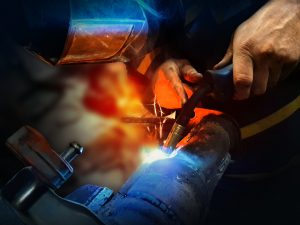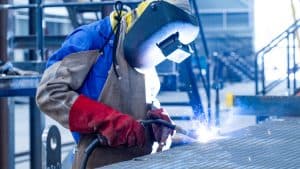This is a great way to join two base materials together by passing a solid wire electrode continuously through a wielding gun. An electric arc forms in-between the work piece metals and the wire electrode. Its various sub forms – metal active gas (MAG) and metal inert gas (MIG) help in identifying the wielding process. One of the best benefits of having MIG is that anyone can do it with ease. You can use it for automotive chassis repairs or fabrication.
MIG wielding started in the 1940s and has grown in popularity to become of the most used wielding techniques in many fabrication shops. Here you will have high production with very little possibility of the gas been blown by air.
How MIG wielding works
If you are thinking about MIG wielding just know they are pretty easy to use. With MIG you can wield metal sheets or pipes the scope of work to be done is large. Before, wielding it is vital you know how the arc welder works. The arc welder joins metals by allowing a high electric voltage generate a weld through heat. What really differentiates the MIG wielding from the rest is the creation of a gas shield.
A gas shield is formed due to flux, which is as a result of gas chemical reactions. The gasses are often released from the gas cylinder. When flux is used in MIG it refers to metal inert gases. The point is none of the gasses being used in MIG actually react with the metals being joined together. These gases will be passed along through a nozzle in the wielding wire. You can adjust the MIG wielder to a variety of heat settings and this helps determine your type of weld. Getting this settings right is a matter of skill.
Advantages of MIG

Ease of use
The reason for the high popularity of MIG is that it is relatively easy to use when compared to other wielding methods. It is a wielding method that can be used by both novices and professionals. Most wielding trainers can attest to giving a novice basic MIG training in under 20 minutes. Most of the time is spent cleaning the weld rather than knowing how to use the wielder. You can try out the wielding technique for home use or high production fabrications.
Higher productivity
One of the nice things you will notice with MIG in commercial fabrication is the number of welds you can do in a day. For one you eliminate the need to chip away slags, change rods, and repeatedly brushing the weld. Due to this simplicity a fabricator can work on more items with a MIG than other wielding options.
Versatility
Many fabricators prefer using MIG due to its ability to work with a variety of alloys and metals. Initially, MIG was relegated to just magnesium and aluminum alloys but things have changed to incorporate a variety of metals like mild steel, aluminum, nickel, and stainless steel. It also works on a variety of alloys.
Production of high quality welds
MIG wielding is slug free and this produces some high quality welds. You do not suffer cases of the slag getting caught in the weld. MIG offers the fabricator better control of the auto-feed wire and this means you have better weld visibility. Even a novice can produce a good looking weld with great ease.
Clean and efficient
Unlike other wielding techniques that requires one to remove the slag, MIG offers arc protection through shielding gas. This means a welder can move on to the next project fast. The MIG electrode is continuously fed meaning you do not need to stop and start your wielding job. You also do not suffer from what we call sub-loss. This is the loss of the wielding stick.
Disadvantages
High Initial MIG wielding costs
When you are starting out on MIG wielding you will notice that the initial setup costs are a bit high. You have the costs of purchasing the MIG wielder coupled by costs for accessories like electrodes, shielding gas, nozzles and replacement tips. However, this costs should be accessed as a long term investment. The MIG wielder will last you a lifetime without the need for constant replacement. In addition, if you have a modern wielder you can use it for stick wielding. The MIG wielder is a complicated machine meaning you will face higher maintenance costs. Maintenance is critical if you want to remain safe during MIG wielding.
Portability
One of the first resistances for using the MIG was its lack of portability. The machines weighed a lot hence making them difficult to move around. Matters get complicated when you consider that you still may require to move with you a generator and gas cylinder. However, things have changed and we now have lighter MIG wielders. Torches have also undergone innovation to make them less cumbersome and easy to move around. If you are not traveling a lot with your wielder then portability may not be such a serious problem in MIG wielding.
Limited positions
You will need to first take into account the kind of jobs you will be doing with your MIG wielder before purchasing it. This is because the MIG wielder does not allow overhead or vertical heating. This is due to the high heat input and the welding puddle. To solve this problem choose a MIG wielder that also accommodates stick wielding.
Not suitable for outdoor welding

MIG is not very suitable for outdoor welding as you use shielding gas to protect the weld purity. If you are in an area that experiences large gusts of wind then this will compromise the quality of your MIG weld. Lack of portability also makes the technique not suitable for outdoors.
Not suitable for thick metals
MIG offers little penetration for thick metals and is more suitable for thin metals. You also may experience some serious burn-through of metals that are less than .5mm.
Preparation time
For you to make a good weld with the MIG welder you need to ensure that the metallic surfaces are free from dust and rust. This requires some preparation time. It also takes some time to replace the shielding gas bottle.
How to improve your MIG welds
Many welders focus so much on making the perfect weld that they forget about their safety. Welding can be disastrous especially when inflammable substances surround you. During MIG welding you have fumes, hot air and blinding arc rays. If you are not careful this ultraviolet and infrared rays can destroy your eyes or cause serious burns to your skin. In this regards, before you can do any welding work ensure you have closed leather shoes, welding helmet and glasses, and clothes that completely cover your hands. Avoid going to the welding area with clothes that have cuffs as this can easily catch fire or hinder you during welding.
Your gloves should be the thick type especially if you are doing heavy duty MIG welding. This is because the process produces a lot of spatter, heat and sparks.
The MIG wire plays a vital role in the kind of welds that you use. For most applications you will need the ER70S-3 but if you plan on welding into rusty metal then the ER70S-6 will work out just fine. This one comes loaded with deoxidizers that help keep oxygen from coming into contact with carbon and forming carbon monoxide. If you are welding thin metal then it is okay to use a MIG wire with a thickness of 0.023-inches while for heavier applications a 0.035 to 0.045 inch wire will do just fine.
Before starting ensure that all your MIG connections are proper. It is not unusual to attempt to weld only for the welding machine to fail you. Start from the power source, to the front of the MIG gun. Check your consumables for any signs of spatter. For the feed wire ensure you have the right tension. It should not be too tight or too lose. Poor tension leads to poor wire feeding.
The MIG contact tip is very important as it is the one that is responsible for transferring current to the wire and onto the bore for the arc formation. If you want to prevent excess spatter, insufficient penetration, warping in thinner metals and burn-through then make sure you have the correct contact recess position.
The shielding gas is equally important in getting the right MIG weld. Most of the time you have a mixture of carbon dioxide and argon, in this instance you get 75% argon and 25% carbon dioxide. This mixture gives you the best penetration and cleanest weld.
Conclusion
MIG welding is one of the most preferred welding technique by beginners. It has the shortest learning curve and this helps one start welding as soon as possible. Choosing the right MIG wire is as critical as choosing the right machine. You also have to work on getting the right shielding gas mixture. The downside is this welding technique is not ideal for welding through rusty metal and outside welding.
